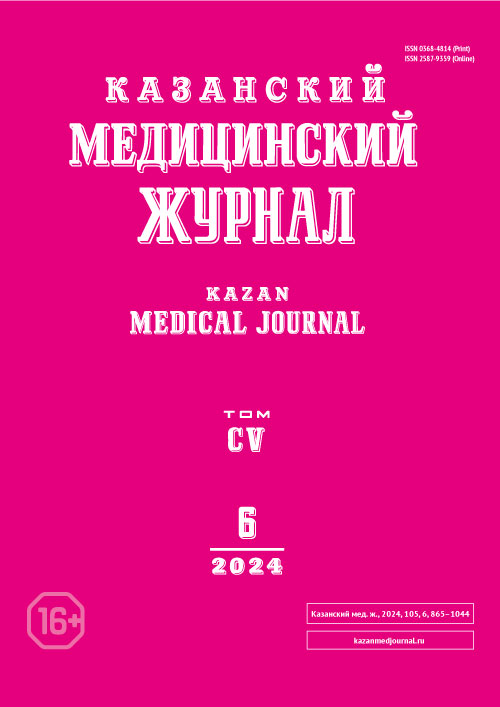Features of inspiratory muscle functional state in patients with heart failure with preserved ejection fraction
- Authors: Ivanov K.M.1, Silkina T.A.1, Baykina N.G.1
-
Affiliations:
- Orenburg State Medical University
- Issue: Vol 105, No 6 (2024)
- Pages: 887-894
- Section: Theoretical and clinical medicine
- Submitted: 21.07.2024
- Accepted: 12.09.2024
- Published: 08.11.2024
- URL: https://kazanmedjournal.ru/kazanmedj/article/view/634448
- DOI: https://doi.org/10.17816/KMJ634448
- ID: 634448
Cite item
Abstract
BACKGROUND: Chronic heart failure contributes to multiorgan dysfunction, including skeletal muscle impairment.
AIM: This study aimed to assess the strength and electrical activity of inspiratory muscles in patients with chronic heart failure with preserved left ventricular ejection fraction.
MATERIAL AND METHODS: Eighty patients of both sexes aged 45–74 years were included and divided into three groups: group 1 comprised 24 patients with chronic heart failure classified as NYHA functional class II, group 2 included 20 patients with NYHA class I chronic heart failure, and group 3 (control group) involved 36 patients without chronic heart failure. All participants underwent evaluation for serum N-terminal pro-B-type natriuretic peptide (NT-proBNP) levels, a 6-minute walk test, assessment of inspiratory muscle strength, and surface electromyography of inspiratory muscles during three loading tests. The significance of intergroup differences was assessed using the Mann–Whitney and Pearson χ2 tests.
RESULTS: When stratified by sex, women in group 1 had 31.5% lower maximal inspiratory pressure than those in the control group (p = 0.006). The patients in group 1 demonstrated a smaller increase in diaphragm electromyography amplitude during the first test—sustained inspiratory effort at 30% intensity for 15 seconds—by 27.9% (p = 0.010), 26.1% (p = 0.025), and 40.7% (p = 0.033) at 5, 10, and 15 seconds, respectively. In the second test—sustained inspiratory effort at 50% intensity for 5 seconds—electromyography amplitude decreased by 32.6% (p = 0.041) at 5 seconds. In the third test—sustained inspiratory effort at 70% intensity for 5 seconds—the reduction was 42.8% (p = 0.009) at 5 seconds compared with the control group. Additionally, a more pronounced decrease in electromyography frequency was observed during the first test—by 24.2% (p = 0.048) and 24.7% (p = 0.030) compared with the control group—indicating fatigue. In the accessory inspiratory muscles, electromyography amplitude gain was higher in group 1 than in the control group, showing activation of additional motor units: in the external intercostal muscles during the first test, by 31.7% (p = 0.032) and 37.9% (p = 0.044) and by 28.9% (p = 0.048) and 43.1% (p = 0.036) during the second test; and in the sternocleidomastoid muscle during the first test by 66.1% (p = 0.033) and 49.4% (p = 0.043) and by 128.6% (p = 0.032) during the second test.
CONCLUSION: Surface electromyography with loading tests revealed diaphragm fatigue and increased activation of accessory inspiratory muscles in patients with NYHA class II chronic heart failure.
Full Text
About the authors
Konstantin M. Ivanov
Orenburg State Medical University
Email: kmiwanov@mail.ru
ORCID iD: 0000-0002-7614-337X
SPIN-code: 3888-1367
MD, Dr. Sci. (Med.), Prof., Head of Depart., Depart. of Propaedeutics of Internal Diseases
Russian Federation, OrenburgTatiana A. Silkina
Orenburg State Medical University
Author for correspondence.
Email: tanya.muz@mail.ru
ORCID iD: 0000-0002-5875-8530
SPIN-code: 8257-2144
Postgrad. Stud., Assistant, Depart. of Propaedeutics of Internal Diseases
Russian Federation, OrenburgNatalia G. Baykina
Orenburg State Medical University
Email: natasha_shkatova@mail.ru
ORCID iD: 0000-0002-0777-3909
SPIN-code: 5249-3442
Assistant, Depart. of Propaedeutics of Internal Diseases
Russian Federation, OrenburgReferences
- Groenewegen A, Rutten FH, Mosterd A, Hoes AW. Epidemiology of heart failure. Eur J Heart Failure. 2020;22(8):1342–1356. doi: 10.1002/ejhf.1858
- Arutyunov AG, Ilyina KV, Arutyunov GP, Kolesnikova EA, Pchelin VV, Kulagina NP, Tokmin DS, Tulyakova EV. Morphofunctional features of the diaphragm in patients with chronic heart failure. Kardiologiia. 2019;59(1):12–21. (In Russ.) doi: 10.18087/cardio.2019.1.2625
- Vatutin NT, Shevelyok AN, Sklyannaya EV, Linnik IG, Kharchenko AV. Respiratory muscles training in the complex treatment of patients with acute decompensated heart failure. Russian Archives of Internal Medicine. 2022;43(2):11–19. (In Russ.) doi: 10.20514/2226-6704-2022-12-1-62-71
- Taylor BJ, Bowen ST. Respiratory muscle weakness in patients with heart failure: Time to make it standard clinical marker and a need for novel therapeutic interventions? J Card Failure. 2018;24(4):217–218. doi: 10.1016/ j.cardfail.2018.02.007
- Begrambekova JL, Karanadze NA, Mareev VYu, Kolesnikova EA, Orlova YaA. Integrative respiratory and skeletal musculature training in patients with functional class II–IV chronic heart failure and low or intermediate left ventricular ejection fraction: Design and rationale. Siberian Journal of Clinical and Experimental Medicine. 2020;35(2):123–130. (In Russ.) doi: 10.29001/2073-8552-2020-35-2-123-130
- Luiso D, Villanueva JA, Belarte-Tornero LC, Fort A, Blázquez-Bermejo Z, Ruiz S, Farré R, Rigau J, Martí-Almor J, Farré N. Surface respiratory electromyography and dyspnea in acute heart failure patients. PLoS ONE. 2020;15(4):e0232225. doi: 10.1371/journal.pone.0232225
- Bubnova MG, Persiyanova-Dubrova AL. Six-minute walk test in cardiac rehabilitation. Cardiovascular Therapy and Prevention. 2020;19(4):102–111. (In Russ.) doi: 10.15829/1728-8800-2020-2561
- Evans JA, Whitelaw WA. The assessment of maximal respiratory mouth pressures in adults. Respir Care. 2009;54(10):1348–1359. PMID: 19796415
- Wilson SH, Cooke NT, Edwards RH, Spiro SG. Predicted normal values for maximal respiratory pressures in caucasian adults and children. Thorax. 1984;39(7):535–538. doi: 10.1136/thx.39.7.535
- Segizbaeva MO, Aleksandrova NP, Timofeev NN, Kuryanovich EN. EMG-analysis of the different inspiratory muscles fatigue during exhaustive exercise. Mezhdunarodnyi zhurnal prikladnykh i fundamental'nykh issledovanii. 2016;(6-5):898–902. (In Russ.) EDN: WAPCGJ
- Ploesteanu RL, Nechita AC, Turcu D, Manolescu BN, Stamate SC, Berteanu M. Effects of neuromuscular electrical stimulation in patients with heart failure review. J Med Life. 2018;11(2):107–118. PMID: 30140316
Supplementary files











